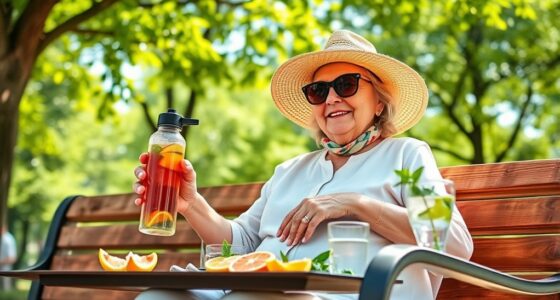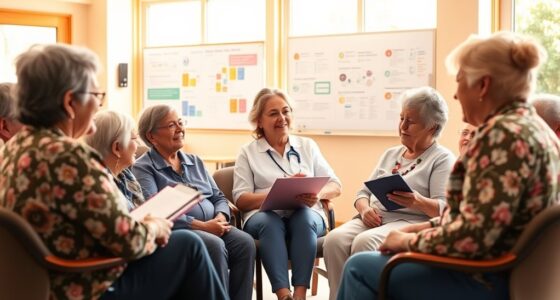Staying active is essential for seniors to boost strength, improve balance, and enhance mental health. By incorporating safe, balanced routines that include strength, flexibility, and gentle cardio exercises, you can reduce fall risks and chronic conditions. Starting small with regular sessions and gradually increasing intensity helps you build confidence and consistency. Explore effective activities and helpful resources to keep moving safely and enjoy a healthier, more independent lifestyle as you learn more about tailored routines.
Key Takeaways
- Incorporate a mix of strength, flexibility, and aerobic exercises tailored to individual health levels.
- Start with small, manageable sessions focusing on consistency and gradually increase intensity.
- Include balance exercises like tandem stands and single-leg balances to prevent falls.
- Use low-impact activities such as walking, water aerobics, or yoga to promote joint health and cardiovascular fitness.
- Ensure proper warm-up, cool-down, and safety modifications, and seek professional guidance when needed.
Benefits of Regular Exercise for Seniors
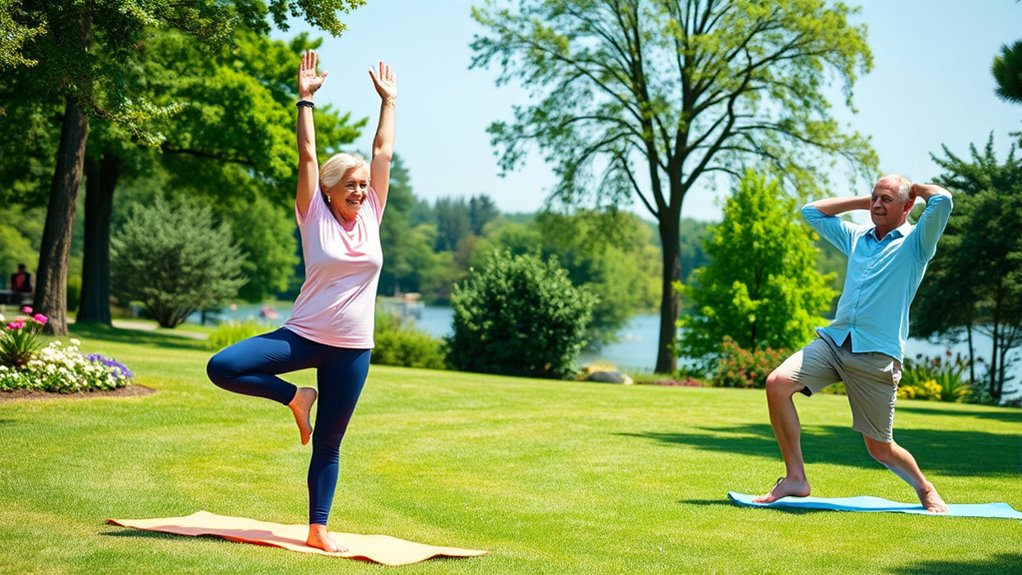
Regular exercise offers numerous health benefits for seniors, helping them stay active and independent.
The benefits of exercise for seniors include boosting physical activity levels that improve balance exercises and flexibility, which can markedly reduce the risk of falls and injuries. Regular exercise also enhances muscle strength and bone density, supporting mobility and overall strength. Incorporating preventive health measures such as routine check-ups and appropriate activity levels can further optimize health outcomes for seniors. These activities are linked to better mental health, helping to decrease symptoms of depression and cognitive decline. Additionally, engaging in consistent physical activity improves cardiovascular health, reducing the risk of heart disease and diabetes. Research indicates that incorporating sound healing practices such as calming music or vibrations can further support mental well-being during exercise routines. Moreover, celebrity transformations highlight the importance of maintaining health and vitality at any age, inspiring seniors to stay motivated in their exercise routines. Staying hydrated and making accessible exercise options available can also enhance participation and safety during physical activity. Exploring innovative fitness programs designed specifically for seniors can help tailor routines to individual needs and abilities. Meeting the recommended 150 minutes of moderate exercise weekly can promote healthy aging, extend lifespan, and improve quality of life. Staying active through regular exercise is essential for maintaining independence and overall well-being as you age.
Essential Components of a Safe Exercise Routine
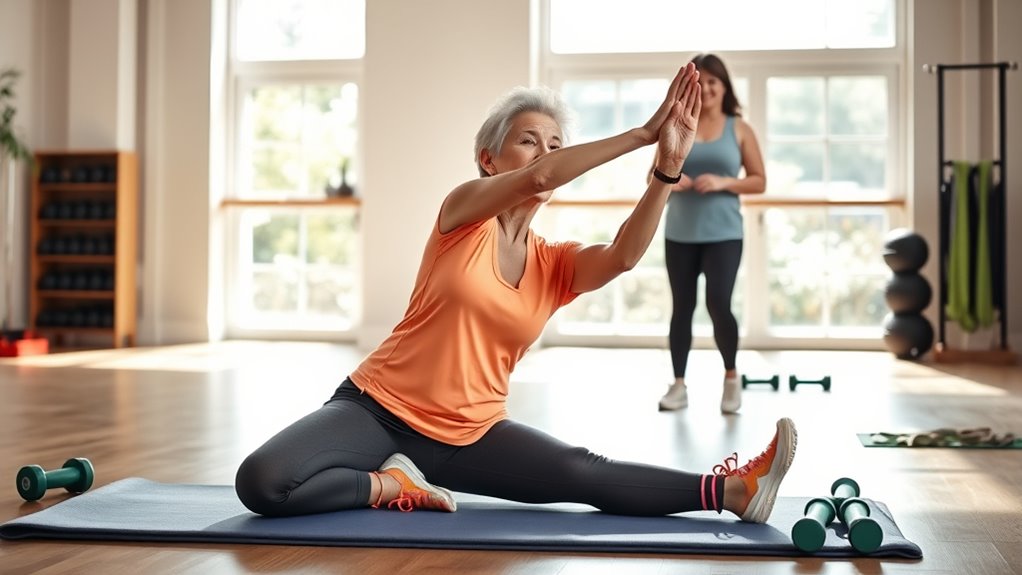
Creating a safe exercise routine for seniors involves including key components that protect your health and maximize benefits. Start with a warm-up to prepare your muscles and reduce injury risk, and finish with a cool-down to prevent soreness. Incorporating encouragement and motivation can help maintain consistency and a positive outlook on your fitness journey.
Incorporate balanced exercises—like strength, flexibility, and aerobic activities—that suit your fitness levels. Safety modifications are essential; adapt movements based on your individual health conditions and physical limitations.
Regular monitoring of how you feel during exercise helps prevent overexertion and ensures you’re progressing gradually. Always listen to your body and avoid pushing too hard too fast.
An individualized exercise routine, designed with these components, promotes safety, enhances fitness, and makes staying active both effective and enjoyable. Return policies are an important consideration when purchasing exercise equipment or clothing.
Effective Strength and Balance Activities
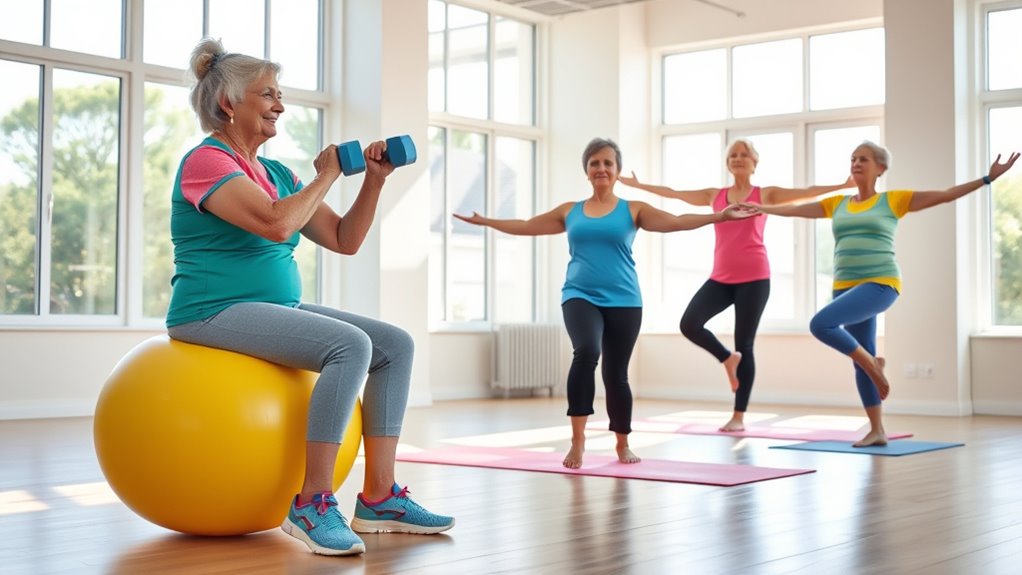
To improve your overall stability and strength, incorporating targeted exercises like wall pushups, pelvic tilts, and toe taps is highly effective. These strength activities support muscle mass and joint stability, which are essential for senior fitness.
Balance exercises such as tandem stance, single-leg stands, and weight-shifting enhance stability and fall prevention. Resistance exercises done twice a week bolster functional strength, helping with daily tasks.
Regularly practicing these routines can decrease fall risk by up to 23%. To maximize benefits, consider:
- Performing balance exercises daily to improve stability
- Including resistance exercises in your routine twice weekly
- Combining strength activities with mobility routines for overall independence
- Focusing on functional strength to support everyday movements
These stability training strategies are crucial for older adults seeking to maintain mobility and reduce fall risk.
Incorporating Cardio and Low-Impact Exercises
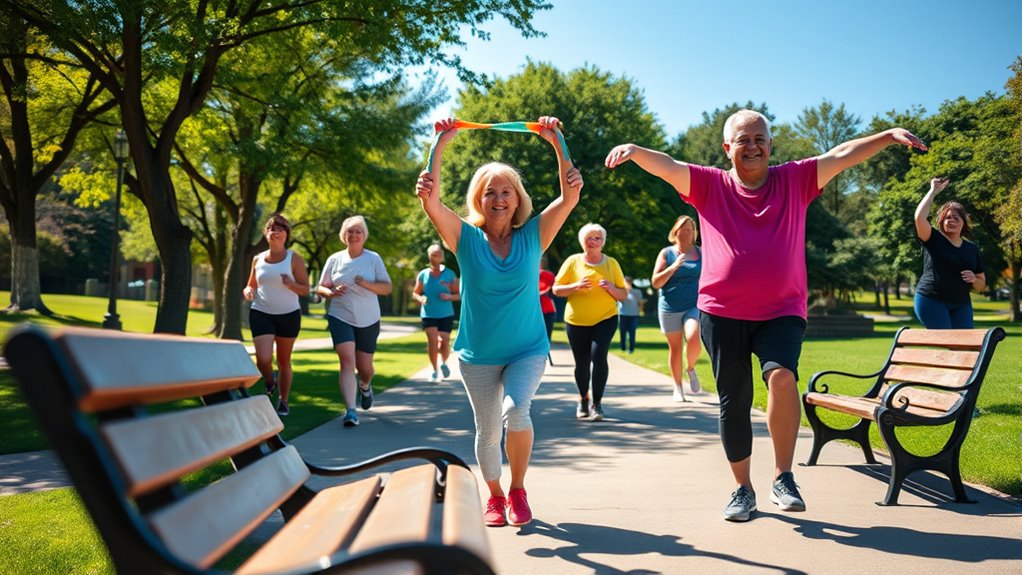
Incorporating cardio and low-impact exercises into your routine can considerably boost your cardiovascular health and overall mobility. Aim for at least 150 minutes of moderate activity weekly, like brisk walking, water aerobics, or cycling. These cardio exercises enhance endurance and support falls prevention. Low-impact exercises such as gentle yoga or stationary biking promote joint-friendly movement, reducing stress on your joints while improving cardiovascular health. Short, 15-minute sessions of water aerobics or brisk walking can make a big difference in daily activity levels. Here’s a quick guide:
| Exercise Type | Benefits | Examples |
|---|---|---|
| Cardio Exercises | Improve heart health, endurance | Brisk walking, swimming |
| Low-Impact Exercises | Joint-friendly movement | Water aerobics, yoga |
| Overall Benefits | Increased mobility, energy | Falls prevention |
Focusing on risk assessments can help tailor exercises to individual needs, ensuring safety and effectiveness. Additionally, maintaining proper air quality in your environment, such as using an air purifier with regular filter maintenance, can support respiratory health during your activity routines. Engaging with educational resources about safe exercise techniques can further enhance your confidence and outcomes. Incorporating materials used in your environment, like clean flooring and furniture, can also contribute to healthier respiratory conditions. Regularly vacuuming your living space with a high-efficiency vacuum can reduce dust and allergens that may affect respiratory health, especially important for seniors.
Mobility and Flexibility Movements to Maintain
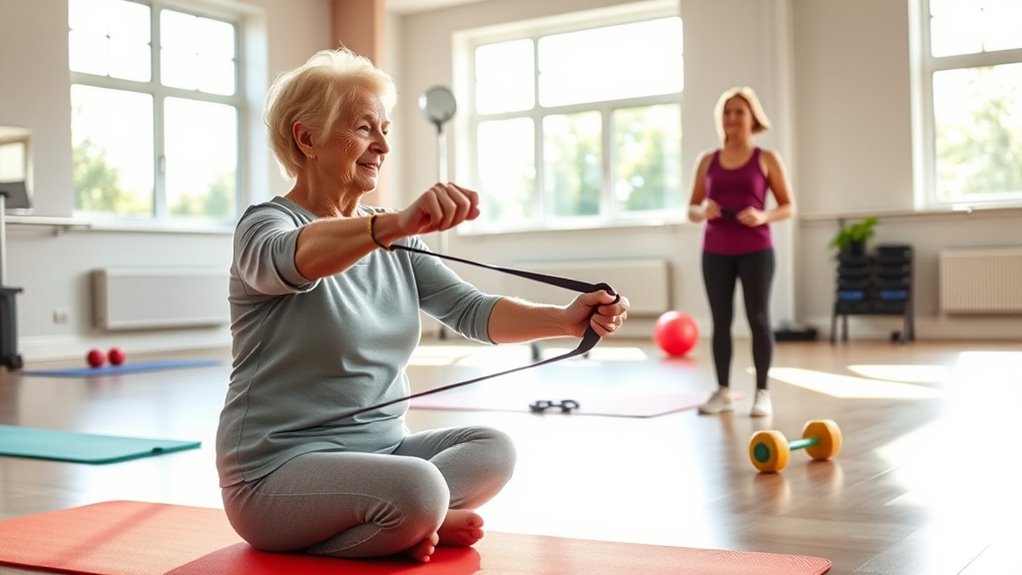
Building on your cardio and low-impact routines, focusing on mobility and flexibility movements helps maintain joint function and ease daily activities. Regular stretching and gentle movements improve mobility and reduce stiffness in seniors. Incorporating educational toys into your routine can also stimulate mental engagement and promote overall well-being. Additionally, advances in AI in education are making personalized learning tools more accessible, which can support cognitive health alongside physical activity.
Incorporate these daily exercises to support your joint range of motion and prevent age-related decline:
- Neck stretches and shoulder rolls
- Hip rotations and seated leg lifts
- Wrist stretches and ankle circles
- Upper back and shoulder stretches
These flexibility routines promote better posture, alleviate tension, and enhance overall comfort.
Tips for Starting and Staying Consistent
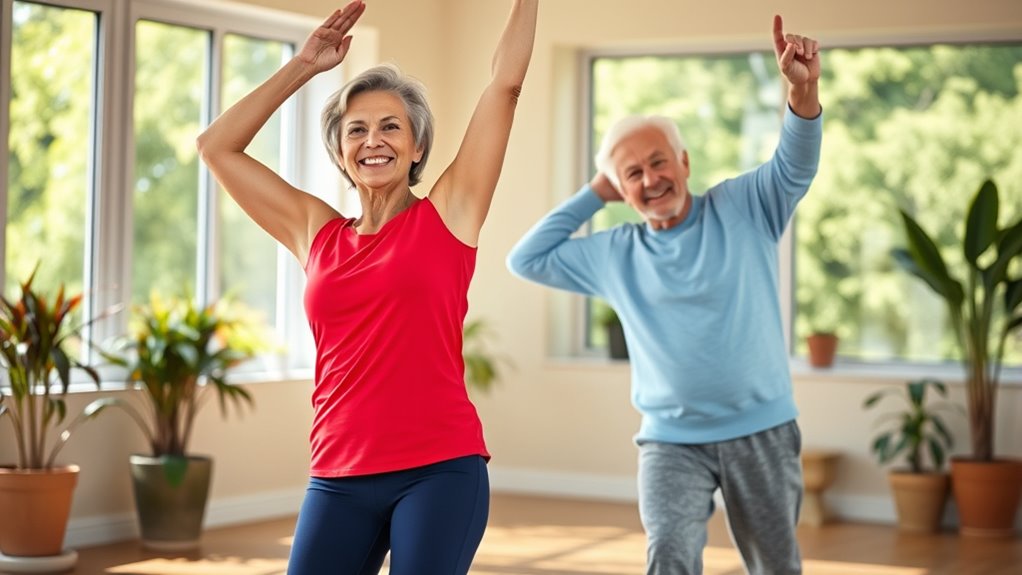
Starting your exercise routine can feel overwhelming at first, but breaking it into small, manageable steps makes it easier to stay committed. Begin with safe exercises like short, 5-10 minute sessions to build confidence and prevent burnout. Incorporating gradual progression helps prevent injury and promotes steady improvement. Find activities you enjoy, such as walking, dancing, or water aerobics, to boost motivation and make staying active more enjoyable. Establish a regular activity schedule by exercising at the same time each day, helping to develop a sustainable habit. Track your progress with a journal or app to see improvements and stay motivated. Remember, a gradual increase in duration and intensity supports building confidence and avoids injury. Consistency is key to experiencing the full health benefits of a well-rounded exercise routine. Additionally, regularly reviewing your goals and celebrating small wins can help maintain motivation and adapt your routine as needed to stay on track. Incorporating exercise safety tips can further ensure a positive and injury-free experience as you progress. Staying informed about AI-related jobs can also be beneficial for those interested in tech careers, providing new opportunities for growth and development.
Recommended Resources and Program Ideas
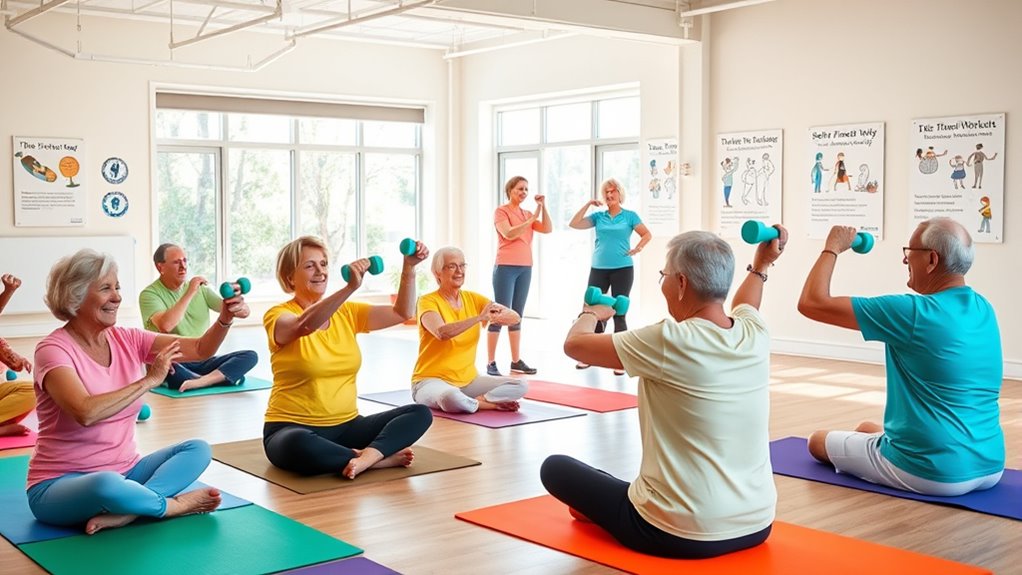
Finding the right resources can make a big difference in maintaining an exercise routine as a senior. SilverSneakers offers excellent options, including free access to wellness programs, group classes, and online tools to locate classes and track progress. Incorporating low-impact workouts can help prevent injury and make exercise more accessible for seniors. These resources support your journey with safe exercises tailored for senior fitness, such as balance exercises, strength training, and low-impact workouts. To get started, explore:
- SilverSneakers memberships through Medicare Advantage plans
- Local group classes focusing on safe, effective exercise routines
- Online tools for finding nearby classes and wellness tips
- Incorporating balance exercises and strength training into your routine
Engaging in cybersecurity awareness can help protect your personal information when exploring online fitness resources. Additionally, selecting appropriate exercise equipment like hybrid bikes designed for comfort and stability can enhance your activity options and help maintain motivation. Incorporating professional guidance from fitness experts can also improve safety and effectiveness in your workouts. Staying informed about health and safety regulations ensures you exercise within recommended guidelines and reduces the risk of injury. These resources help keep your workouts enjoyable, safe, and effective, encouraging a healthy, active lifestyle.
Frequently Asked Questions
What Is the Best Exercise Routine for Seniors?
You should aim for a balanced routine combining aerobic activities, strength training, flexibility, and balance exercises. Walk or do water aerobics for about 150 minutes weekly to boost your stamina.
Incorporate strength moves like wall pushups twice a week, and practice tai chi or single-leg stands to improve stability.
Always tailor your routine to your health, and consult your doctor before increasing intensity to stay safe and effective.
What Is the 5 5 5 30 Exercise?
Think of the 5 5 5 30 exercise as a mini-road trip for your body. You perform five simple, targeted movements—like squats and arm raises—for five repetitions each, all within a 30-minute session.
This routine helps you build strength, improve balance, and boost mobility. It’s easy to fit into your day, keeping your fitness journey manageable and steady, like a well-planned route to better health.
What Activities Are Good for Elderly People to Stay Active?
You’re wondering what activities help elderly people stay active. You should consider low-impact options like walking, swimming, or cycling, which boost your cardiovascular health.
Incorporate chair yoga, resistance band exercises, or tai chi to improve flexibility and strength without stressing your joints.
Water aerobics offers gentle resistance training, while balance exercises like tandem stands help prevent falls.
Joining dance classes or group walks keeps you socially engaged and motivated to stay active regularly.
What Is the Number 1 Exercise to Increase Balance in Seniors?
The number one exercise to boost your balance is the Single-Leg Stand. It helps improve proprioception and muscle coordination, which are key for stability.
You should aim for 30 seconds to a minute on each leg, supporting yourself with a chair or wall as needed. As you get stronger, try closing your eyes or shifting your weight to challenge your balance even more.
Regular practice reduces fall risk and increases confidence.
Conclusion
Staying active is essential—you’ll reduce your risk of falls by up to 40% and boost your overall well-being. Remember, starting slow and including a mix of strength, balance, and flexibility exercises can make a big difference. Keep consistent, find activities you enjoy, and use available resources for support. Embrace movement daily; it’s your best investment in staying healthy and independent as you age.


